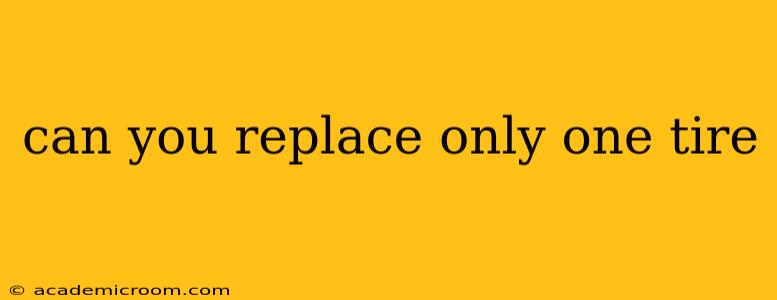Can You Replace Only One Tire?
Yes, you absolutely can replace only one tire. However, whether you should replace only one tire depends entirely on the circumstances. Replacing just one tire is often necessary, but it's crucial to understand the implications to ensure your safety and the longevity of your vehicle.
This article will delve into the reasons why you might replace only one tire, the potential consequences of doing so, and best practices to keep in mind.
Why Would I Only Replace One Tire?
There are several valid reasons to replace just a single tire:
-
Puncture or Damage: This is the most common scenario. A flat tire, a significant sidewall cut, or other damage to a single tire necessitates its replacement. It's unsafe and impractical to repair significant tire damage in many cases.
-
Uneven Wear: While less common, sometimes only one tire wears out significantly faster than the others. This might be due to a misalignment issue, a faulty suspension component, or simply an inherent variation in tire wear patterns. Replacing only the worn tire might be a temporary fix until the underlying cause is addressed.
-
Spare Tire Replacement: If you use your spare tire, you'll inevitably need to replace it at some point with a regular tire.
What Are the Potential Consequences of Replacing Only One Tire?
Replacing a single tire without careful consideration can lead to several problems:
-
Uneven Tread Depth: Different tread depths between tires can affect handling and braking, especially in wet or icy conditions. This is because the tires don't grip the road equally. Significant differences in tread depth can lead to a loss of control.
-
Uneven Tire Wear: If the underlying cause of the single tire failure wasn't addressed (e.g., misalignment), the new tire will likely wear out prematurely. You might find yourself replacing tires more frequently and incurring higher costs in the long run.
-
Handling Issues: Even with similar tread depth, using tires of different ages or brands can negatively impact handling. The tires might respond differently to steering inputs, making the car feel unstable or unpredictable.
-
Traction Problems: Uneven tire wear or different tire types can impair traction, particularly during acceleration or braking, leading to reduced safety.
Should I Replace All Four Tires at Once?
While not always necessary, replacing all four tires simultaneously is often the recommended approach, especially if:
-
The tires are nearing the end of their lifespan: It's more cost-effective to replace all four tires at once than to replace them individually over time.
-
There's significant tread wear variation: Replacing only one tire while others have substantial wear can create handling and traction imbalances.
-
The tires are of different brands or types: Maintaining consistent tire performance across all four wheels is crucial for safe and predictable handling.
-
You've just experienced a significant event (e.g. blowout): The impact could have subtly damaged other tires or the suspension, making preventative replacement of all four tires advisable.
What Type of Tire Should I Replace With?
Always replace your tire with one that matches the specifications of the other tires on your vehicle. Check your vehicle's owner's manual for the correct tire size, load index, and speed rating. Using mismatched tires can lead to severe handling issues and safety risks.
How Often Should I Rotate My Tires?
Tire rotation is crucial to even out wear and prolong the lifespan of your tires. Consult your vehicle's owner's manual for the recommended rotation schedule. Regular tire rotations can prevent premature wear and ensure optimal performance.
In conclusion, while replacing only one tire is sometimes necessary, it's important to be aware of the potential drawbacks and consider the overall condition of your tires. In many cases, replacing all four tires simultaneously offers greater safety, better handling, and cost-effectiveness in the long run. Always prioritize safety and consult with a qualified tire professional if you have any doubts.
